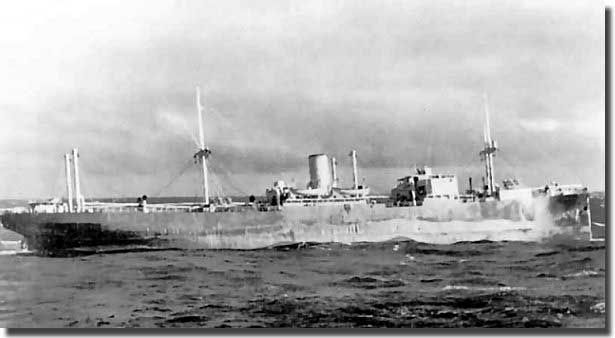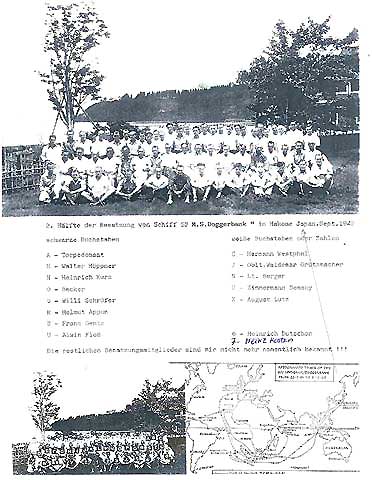|
The Auxiliary German Minelayer Doggerbank
Introduction. A new Captain for Speybank. The ship was quickly captured, her crew transferred to Atlantis, her Captain Rogge decided this ship and her valuable cargo would be sent off to Germany. A prize crew went on board commanded by a young officer Paul Schneidwind, who successfully took his new command back to Bordeaux, France, arriving on the 10th. of May 1941. Speybank becomes Doggerbank.
Speybank prior to her conversion Her conversion fitted her out to carry a cargo of some 280 mines made up of: 115 Type EMC, 55 Type EMF, and 709 Type TMB mines, in addition she carried 50 torpedoes so that she could resupply U-Boats she was scheduled to meet. Paul Schneidewind retained his command of the German Navy's latest Auxiliary Mine-Layer, and he put to sea in mid June 1942, escorted by U-432, bound for the South Atlantic and Operation Kapenhagen to lay a minefield off the South African port of CapeTown, the convergence of shipping lanes bound both east and west. This route was used by ships to and from Australia and New Zealand, and troop reinforcements had been forced to take the long way round the Cape to the Middle East, as the Axis forces were in virtual control of the Mediterranean. Doggerbank sailed under the name of Levernbank, and safely made the Cape by late February. This ship was not fitted with mining rails, which allowed mines to be prepared, then rolled along the rails or tracks, and launched through a stern opening, they had to be hoisted onto the main deck, and prepared, then in due course hoisted over the side. 75 mines thus sat on deck, disguised as deck cargo, all was in readiness for the first drop by the 12th. of March, but that afternoon, an aircraft approached, and wanted to know the ship's name and her destination port. Doggerbank's Captain replied:" Levenbank ex New York via Recife for Capetown," he then waved his cap a few times and left his bridge. This seemed to satisfy the nosy aircraft which then flew off. On the next morning, sixty deadly mines were laid off the Cape of Good Hope, waiting to trap unwary approaching ships as they made for port after their long voyage. Doggerbank was now sailing to lay more mines off Cape Agulhas, and at 1945 ( 8. 45 PM ) she ran into the old British light cruiser HMS Durban, who promptly wanted to know her secret letters of identification, naturally Doggerbank did not have these available, and ignored that request. Durban edged in closer, and demanded " What Ship?" Maintaining his coolness, Schneidewind merely replied " Leverbank from New York to Durban . Goodnight!" A satisfied Durban now took off apparently quite happy with this exchange. Not to tempt fate anymore, the Captain of Doggerbank decided to quickly lay the last 16 prepared mines, and move away from this area as soon as he could. But, now on the 14th. he ran into the British Armed Merchant Cruiser HMS Cheshire, at first Doggerbank tried to outrun the enemy ship, but arousing suspicion, he turned his Mine-Layer around, and steamed directly towards the AMC on an opposite course, as he came closer, the anticipated question was signalled from Cheshire, "What Ship?" He replied, "Levernbank from Montevideo to Melbourne." his signalman now hoisted Levernbank's call sign, and the Red Ensign was run up. Cheshire was appeased and offered "I wish you a Happy voyage." and Doggerbank politely replied " Many thanks, same to you." The German bluff had twice worked, and now when all was clear, Doggerbank made off southwards. Increased radio traffic set Schneidewind thinking that his laid minefields had obtained some victims, and he was right. The Victims. Ironically, a former German ship sailing for the Allies was damaged by a former British ship now in German hands. Another mine field is laid. The problems with a Mine field. They will also have to allocate mine sweepers to try and sweep up all the laid mines, in itself a dangerous occupation., eg in Australian waters post WW2, the MineSweeper HMAS Warrnambool was clearing a minefield off the Queensland coast, and hit a mine to sink. A normal mine layer is fitted with mine rails on its main deck, mines are prepared, then launched in a regular pattern through a stern opening. In the case of Doggerbank, she was not fitted with mine rails, all mines had to be brought onto the upper deck from their stowage below, prepared, and then hoisted out and dropped. This would result in a more haphazardly laid field than one that was layed via rails from a conventional layer. Thus, finding the limits and extent of Doggerbank's laid mine field would be more difficult. The type of mine laid, will dictate the equipment needed to sweep it, eg, a moored mine when released will sink to the bottom and anchor itself, a mooring wire will run out to a preset depth and be activated. The mine, tethered to its base on the ocean floor, will sit below the surface, deep enough to physically hit a loaded ship that passes over it, when one of the horns on the mine is struck, it will activate the charge and explode the mine below the ship's bottom. If the mine used is an accoustic one , there are limits as to the depth of water it may be dropped in, and it is activated by the magnetic field generated by a ship passing over it. To sweep magnetic mines needs special equipment within the mine sweeper. A third type is the pressure mine, it also sits on the bottom, and has limits as to the depth in which it may operate, but the pressure wave developed by a ship's dispacement in the water will set it off. Once again, the mine sweeper needs special equipment to cope with this type of mine. All types of mine are deadly, and gobble up personnel, ships and equipment in trying to find, deliniate, and clear an enemy laid mine field. They also engender fear in ships' in Ships' Companies, at the thought of either approaching or passing through a newly sewn and reported Mine field. Destroyer /Depot Ship, and Transport hit. Doggerbank called an end to her career as a Mine-Layer and met up with the Armed Merchant Raider Michel, and the tanker Charlotte Schliemann in the South Atlantic. Michel was supplied with stores, and relieved of 124 Prisoners of War, all of whom had become such when their particular ship had run into the Armed Merchant Raider.
Michel and the Tanker Charlotte Schliemann in June of 1942. By the 21st. of June, we find Doggerbank at Yokahama. The ship and her crew spent some six months in Japan, and departed for Germany on the 17th. of December 1942. She was filled with the 124 Prisoner's of War, that had all come from the British ship Patella, the US ship Connecticut, the Norwegian Kattegat, the British Gemstone, and finally the Panamanian Stanvack Calcutta, plus 200 survivors ex the German Tanker Uckermark, which had accidentally blown up in Yokahama, and from Thor, the German Armed Merchant Raider, which was claimed in the same disaster. After an uneventful voyage across the Indian Ocean, rounding the Cape of Good Hope and sailing up the western part of Africa, on the 3rd. of March 1943, Doggerbank was some distance to the west of the Canary Islands with her luck about to run out. Lurking below the surface was the German U-Boat U-43, she had been laid down in 1938, to be commissioned the next year. All in all she was to undertake 14 patrols, under Kptlt. Wilhelm Ambrosium, Kptlt. Wolfgang Luth, a Knight's Cross winner, and today was under the command of Oblt. Hans -Joachim Schwantke. This U-Boat had a fine record, to date sinking about 124,000 tons of shipping. Her Captain quite correctly identified lined up in his periscope, a British Merchantship of the Dunedin Star Class, but was totally unaware that she now sailed under German ownership. His crew quickly prepared their torpedoes, and the Captain slipped three of them into her, he had sunk his own Doggerbank. Only 15 crew escaped in a small boat bereft of food or water. It was 26 days later that the passing Spanish tanker Campaamar found this boat with but a single survivor, Fritz Kurt. He told his story, after the boat had capsized, only 6 had survived, but that number included the Captain, then four of these requested that their Captain shoot them, which he did, before taking his own life, leaving only Kurt from the Doggerbank to tell their amazing story. In all, 394 had perished when U-43 fired her deadly torpedo salvo. An awful ending for both the POW's, and all the German sailors. Conclusion. This brought to a final conclusion the somewhat bizarre story of the Doggerbank, an ex British ship captured by the Germans, who sank an ex German Merchant ship captured by the Dutch, only to be despatched by one of their own Country's U-Boats. This then was one of the unusual stories spawned by World War 2.
Doggerbank crew in Japan
Gibson. Charles, "The Ship with Five Names," Abelard-Schumann, London. 1965 "History of Speybank/Doggerbank as a German Mine-Layer". Also printed as another edition. Gibson. Charles, "Death of a Phantom Raider," Robert Hale, London. 1987. Herlin. Hans, "The Survivor. The True Story of the Sinking of the Doggerbank," United States Institute Press, Annapolis. 1995.
Bookcover "The Survivor. The True Story of the Sinking of the Doggerbank," |




